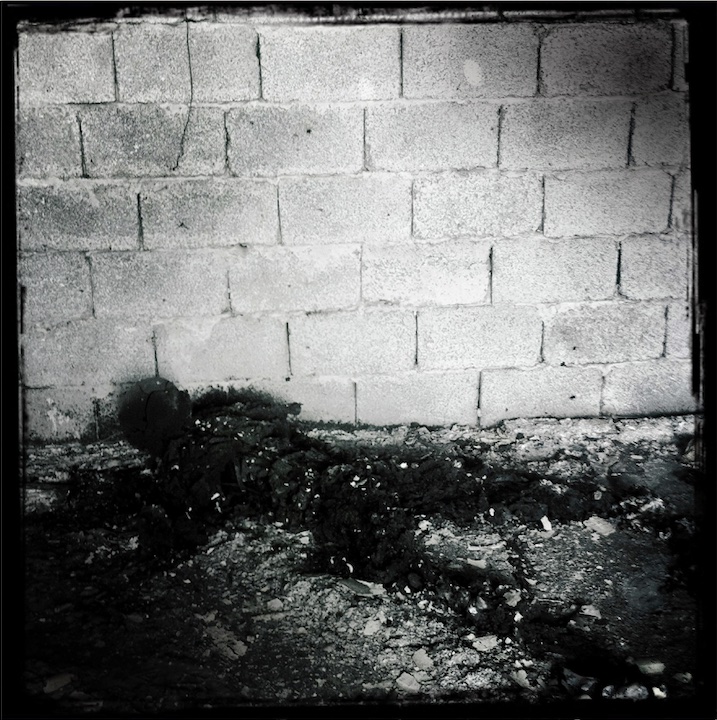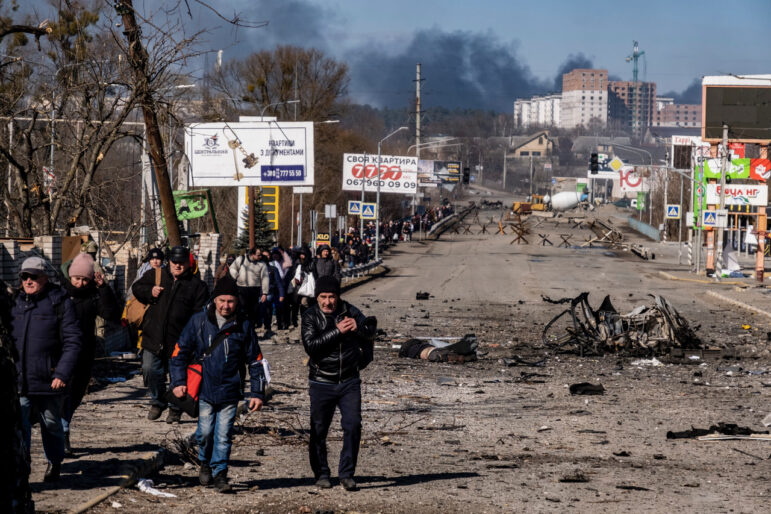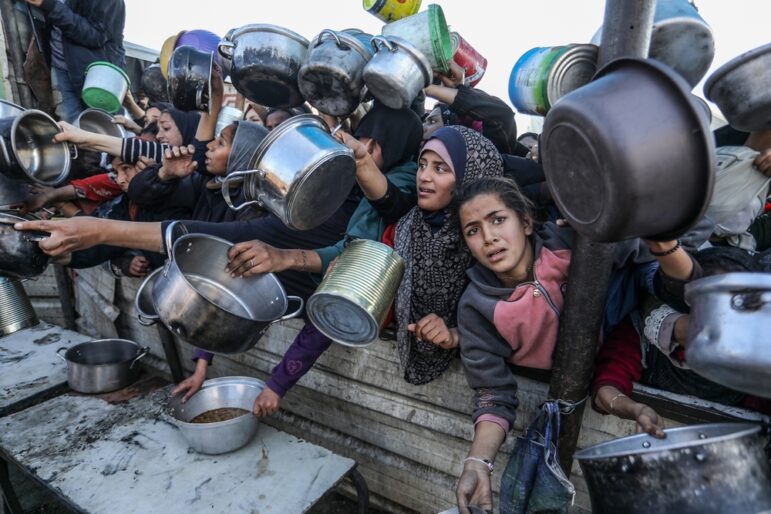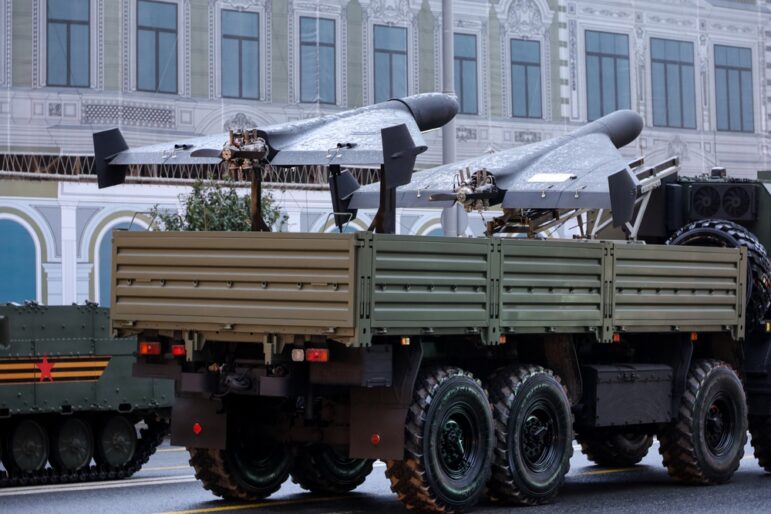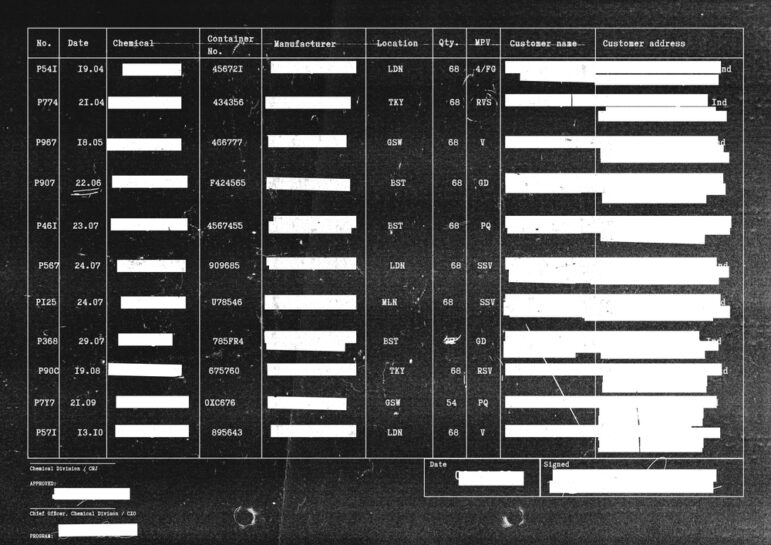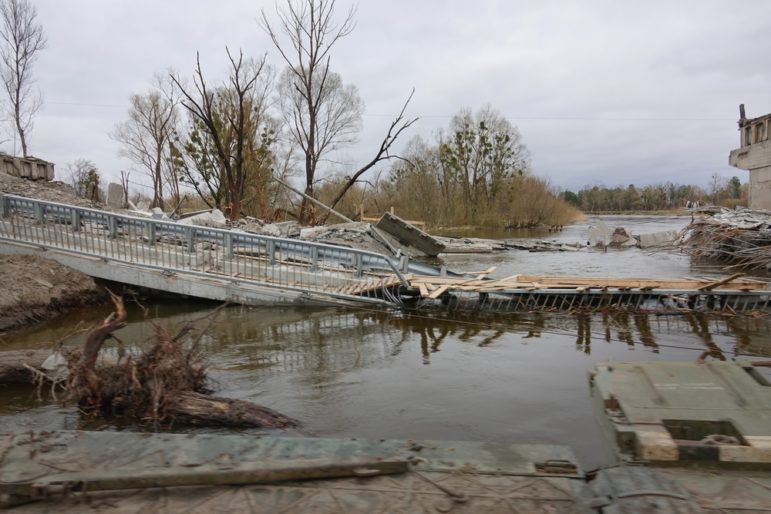

The Tuol Sleng Genocide Museum chronicles the Cambodian genocide. Located in Phnom Penh, the site is a former secondary school showing images of victims held at Security Prison 21 and killed by the Khmer Rouge regime from 1975 until its fall in 1979. Image: Courtesy of Ron Haviv, VII
Investigating War Crimes: What Is Legal in War?
Read this article in
Guide Resource
GIJN Reporter’s Guide to Investigating War Crimes
Chapter Guide Resource
Investigating War Crimes: Introduction
Chapter Guide Resource
Investigating War Crimes: What Is Legal in War?
Chapter Guide Resource
Investigating War Crimes: Attacks on Civilians
Chapter Guide Resource
Investigating War Crimes: Forced Displacement
Chapter Guide Resource
Investigating War Crimes: Starvation
Chapter Guide Resource
Investigating War Crimes: Conflict-Related Sexual Violence
Chapter Guide Resource
Investigating War Crimes: Environmental and Property Damage
Chapter Guide Resource
Investigating War Crimes: Banned and Restricted Weapons
Chapter Guide Resource
Investigating War Crimes: Arms Trade
Chapter Guide Resource
Investigating War Crimes: Combatants and Others Engaged in Hostilities
Chapter Guide Resource
Investigating War Crimes: Genocide and Crimes Against Humanity
Chapter Guide Resource
Investigating War Crimes: Collecting and Archiving Evidence and Information
Chapter Guide Resource
Investigating War Crimes: Open Source Research
Chapter Guide Resource
Investigating War Crimes: Command Structures
Chapter Guide Resource
Investigating War Crimes: Tracing War Criminals
Chapter Guide Resource
Investigating War Crimes: Finding the Missing
Chapter Guide Resource
Investigating War Crimes: Documenting with Photo and Video
Chapter Guide Resource
Investigating War Crimes: Interviewing Victims and Survivors
Chapter Guide Resource
Investigating War Crimes: Physical and Digital Security
Chapter Guide Resource
Investigating War Crimes: Self-Care for Covering Traumatic Events
Chapter Guide Resource
Investigating War Crimes: Resources and Tipsheets
Chapter Guide Resource
Investigating War Crimes
Chapter Guide Resource
GIJN Launches First E-Book — Reporter’s Guide to Investigating War Crimes
The horrors and destruction of war may lead one to believe that no laws apply in conflict, and that any attempt to regulate violence may seem pointless. Yet the very fact that we are horrified by certain acts more than others in such contexts is indicative that we believe that wars should have limits. This is a conviction that can be traced back centuries, although there may not always have been a common understanding of what these limits should be.
Our modern laws of war originate in the 19th century, as states agreed to sign the first international conventions to protect civilians and the sick and wounded in combat. Multiple international treaties have followed, including the four Geneva Conventions of 1949, which have become the most globally recognized texts regarding the laws of war. These four documents were drafted in the immediate aftermath of the Second World War, which had provided a strong incentive for states to write down and commit to respect the commonly accepted rules and customs of war.
The concept of a “war crime” emerged alongside these treaties, as a term to describe the most serious violations of these laws of war. The international prosecution of such war crimes in courts became established with the Nuremberg and Tokyo Tribunals following the Second World War, and in the 1990s with international tribunals in the former Yugoslavia and Rwanda set up by the United Nations.
But the laws of war can also matter outside of the courts. They can matter to individuals harmed by the violence, who may want recognition that they have been a victim of injustice, even if they cannot go to court. They can also matter to soldiers involved in the conflicts, who want to know they are fighting for a just cause in a just manner.
Under international law today, the term “war crime” refers to specific, serious violations of international humanitarian law that lead to individual criminal responsibility. Not all violations of the laws in war are war crimes, however, and not all civilian deaths in war constitute war crimes, or even violations. Furthermore, the applicable laws of war and the enforcement mechanisms available (including international courts) depend on which treaties have been signed by which state.
Although the common understanding of the term “war crime” may have become divorced from the legal context, there is still value in understanding its precise legal meaning as well as the broader laws that apply in war, to ensure credible reporting and possibly contribute to combating impunity for war crimes. It is also important to realize that some acts of war have serious consequences, including loss of life or serious injury of civilians, without being war crimes. Reporting on these acts while recognizing that no legal violation may have occurred can still be important to hold states politically accountable for the reduction of civilian harm in armed conflict.
This chapter lays out a basic overview of the laws that apply in armed conflict – and which acts may or may not be legal. It is not exhaustive and further resources may be found in later parts of this guide. The International Committee of the Red Cross (ICRC) is an authoritative source for the interpretation of the applicable rules in armed conflict, and provides resources useful for journalists reporting in armed conflict.

A radio station broadcaster reads a list of names of missing children twice a day, provided by the ICRC, in the hopes of reuniting families, in Minova, DR Congo, on Jan. 29 2009. Numerous families have been connected this way. Image: Courtesy of Ron Haviv, VII
Laws That Apply
Generally, the following laws apply in armed conflict:
- International humanitarian law (also known as the laws of war or laws of armed conflict), which regulates the actions of states and non-state armed groups parties to a conflict. This body of law deals mainly with state responsibility (or responsibility of armed groups) as opposed to individual responsibility.
- International criminal law, which regulates the international criminal responsibility of individual perpetrators of international crimes (genocide, crimes against humanity, and war crimes) in and outside of armed conflict. Although they are related, international criminal law and international humanitarian law are separate bodies of international law.
- International human rights law, which regulates the obligation of states (and in some cases non-state actors) towards individuals within their territory and/or jurisdiction, although its application may sometimes differ in armed conflict.
- Domestic laws of the states.
- Other international laws and agreements entered into by the state, although their application may differ in armed conflict.
International humanitarian law only applies to situations that are determined to be armed conflicts based on specific legal criteria.
The body of law most relevant to acts of war is international humanitarian law, which only applies during armed conflict and regulates matters such as who may not be targeted (see principle of distinction below), the means and methods that may be used during the conduct of hostilities (such as which weapons are prohibited), and the treatment of those in the hands of the parties to the conflict, including persons in custody as well as persons no longer participating in hostilities.
Types of Armed Conflict
International humanitarian law only applies to situations that are determined to be armed conflicts based on specific legal criteria.
Two different types of armed conflict exist:
- International armed conflicts (often abbreviated as “IAC”) between states.
- Non-international armed conflicts (“NIAC”) between non-state armed groups and a state or between two or more non-state armed groups (sometimes referred to as civil wars, intra-state or internal conflicts).
This distinction matters because the applicable legal framework differs, although the basic fundamental rules remain the same. The two are distinguished by the actors involved. Some conflicts involve both types of armed conflicts, which must be classified separately. Situations of armed occupation, in which a state occupies a part or whole territory of another state, are considered international armed conflicts, and specific rules governing these situations exist in treaty and custom. The existence of an armed conflict – and related applicability of international humanitarian law rules – may not always be clear from the outset (especially for NIACs), but some institutions map the possible existence of conflicts around the world.
Terminology: How ‘Armed Conflict’ Differs from ‘War’
International humanitarian law applies from the start of any “armed conflict.” This is a legal term, distinct but not mutually exclusive from other political terms such as “war.” The outbreak of a “war” may be used in a political sense (e.g. a “civil war,” the “war on drugs,” or the “war on terrorism”), but may or may not include an armed conflict and therefore determine if international humanitarian law applies or not. Legal criteria exist to determine whether or not an armed conflict exists:
- An international armed conflict is triggered by the use of armed force between sovereign states (in theory, even a single shot across borders could meet the definition).
- The existence of a non-international armed conflict depends on the protraction and intensity of violence, and organizational structure of the armed group(s) involved.
Not All Laws Apply to All States
Under international law, states are only bound by the laws to which they have agreed, usually through ratification of treaties (signing and implementing in domestic law), or through customary international law. The UN Treaty Database, the ICRC IHL Database, and other online resources contain lists and information on which states have ratified which treaties.
Parties to an armed conflict are bound by:
- Treaty law
- Which is only binding on the states that have ratified the treaty in question.
- International humanitarian law treaties, such as the Four Geneva Conventions of 1949, which have been ratified by every recognized state (but which lack detailed provisions regarding certain rules, including those applicable to non-international armed conflicts); and their Additional Protocols of 1977 (which have not been ratified by all states, including the US, Pakistan, and Iran).
- International criminal law treaties, such as the Rome Statute of the International Criminal Court, which has been ratified by 123 states. Some notable states that have not ratified this statute include the US, China, Israel, Russia, Ukraine, and Yemen. (See “war crimes courts” below).
- International human rights law treaties, such as the International Covenant on Civil and Political Rights, International Covenant on Economic, Cultural and Social Rights, the European Convention on Human Rights, the Inter-American Convention on Human Rights, and the African Charter on Human and Peoples’ Rights.
- Customary international law
- Which refers to laws derived from the practice of states and their acceptance as law, even though they may not be written down in treaties ratified by that state.
- All parties to an armed conflict are bound by customary international law, including non-state armed groups.
- For example, even though some states have not ratified Additional Protocol I of the Geneva Conventions, which includes the rule that civilians may not be targeted (Article 48), this rule is still considered customary international law binding on all parties to an armed conflict.
- Customary law can be difficult to determine, however. The ICRC customary international law database, while not a legal source in and of itself, is a good reference to understand which rules may exist as customary international law in armed conflict.
The legality of starting an armed conflict is governed by separate rules of international law (laws on the use of force between states). But how or why a conflict started does not affect the rules that apply in armed conflict. In short, the same international humanitarian laws apply whether an armed conflict was started illegally or not.

The International Criminal Court in The Hague, Netherlands. Image: Shutterstock
Rules of War
Detailed rules exist to regulate the conduct of hostilities under international humanitarian law, as well as to afford protections to those not or no longer taking part in hostilities (for example those in detention, the sick, and wounded). The rules laid out below are indicative of some of the main principles and protections under international humanitarian law, but are not exhaustive.
Conduct of Hostilities
Two fundamental rules applicable to the conduct of hostilities are the principles of distinction and the principle of proportionality.
-
Distinction
The principle of distinction dictates that parties to an armed conflict must always distinguish between civilians and those taking part in hostilities (including combatants), as well as between civilian objects and infrastructure and military objectives. Only military objectives and those taking part in hostilities may be lawfully targeted for attack.
Who may be targeted? In terms of persons, only combatants and those taking a direct part in hostilities are lawful targets. However, civilians killed or harmed are not necessarily the result of an unlawful attack, if all the rules of targeting were respected.
What may be targeted? Military objectives include anything that effectively contributes to the military effort by their location, purpose, or use, and whose partial or total destruction would offer a definite military advantage in the circumstances at the time. Objects which are civilian by nature (e.g. civilian buildings, bridges, roads) may therefore become military objectives depending on the circumstances, for example if they are used to house or transport military equipment. Nevertheless, both sides to the conflict have an obligation to avoid the military use of certain civilian objects, especially medical facilities (see below on protected emblems and perfidy).

Bosnian and Croatian prisoners of war at the prison camp in Manjaca, Bosnia, Aug. 22, 1992. All sides of the Bosnian conflict ran prison camps, where many people were killed, and several commanders were later indicted for war crimes. Image: Courtesy of Ron Haviv, VII
If any doubt exists about whether a person or an object is military or civilian, they are presumed to be civilian and prohibited from attack.
Under international humanitarian law, the term “combatant” has a specific legal definition, meaning all members of a state’s armed forces (excluding medical and religious personnel). Combatants are considered military objectives and, thus, can be lawfully targeted, unless they are hors de combat (for example, they are wounded, sick, or have surrendered), and are entitled to prisoner of war status if captured by the enemy.
Under international humanitarian law, anyone who is not a combatant is legally considered a “civilian.” However, civilians may lose their legal protection from attack if they take a direct part in hostilities, although the details of when and for how long they lose this protection are sometimes contested. Members of organized non-state armed groups participating in hostilities may be considered to have lost their protection from attack for the duration of their membership in that armed group. Terms like “fighter” or “continuous combat function” are sometimes used to denote members of these armed groups.
Whatever their actions, both combatants and civilians can never lose all the protections afforded to them under international law, e.g. the right to humane treatment.
-
Proportionality
The principle of proportionality dictates that an attack is unlawful if it will cause civilian harm that is much greater than the direct military advantage anticipated from the attack. For example, bombing a low-value objective, such as an empty military truck, in a busy marketplace, thus killing many civilians, would probably fail the proportionality test.
On the other hand, an attack that causes injury or death to civilians or damage to civilian infrastructure may not be unlawful if the anticipated military advantage is greater than the amount of civilian harm (which is sometimes referred to as “collateral damage” or “incidental harm”). Thus, not all civilian deaths constitute war crimes or violations of international humanitarian law. The proportionality principle depends on what was known at the time of the decision-making and the attack, and is not assessed by evidence that may become clear after the fact. Furthermore, it is based on a balance between humanity and military necessity, for which there is no exact calculation. This can make it particularly difficult to assess compliance.
Precautions in Attack
Deciding whether or not an attack is lawful under international humanitarian law (i.e. whether it respects the principles of distinction and proportionality) requires those planning and carrying out military operations to take feasible precautions when attacking. This includes exercising constant care to spare civilians during military operations, verifying that the objective is military not civilian, cancelling or suspending the attack if the force used will be indiscriminate or disproportionate, and providing warnings in attack when appropriate.
The obligation on precautions also applies to protecting civilians and civilian objects against the effects of attack, for example, by choosing not to station military equipment or personnel in densely populated areas.
Weapons
International humanitarian law further regulates the means and methods of warfare, including in the types of weapons that may or may not be used. This includes weapons that, by their nature, are indiscriminate — if they cannot distinguish between lawful and unlawful targets — and those that would cause superfluous injury or unnecessary suffering. Certain weapons are further prohibited or regulated under certain treaties (e.g. biological and chemical weapons, land mines, expanding bullets).

Roughly four to six million unexploded land mines were left over after nearly three decades of civil war in Cambodia, and the country still experiences dozens of casualties every year from the munitions. Image: Shutterstock
Other Protections Under International Humanitarian Law
International humanitarian law also provides protections for those that are not or are no longer taking part in hostilities. Some of these are summarized here.
-
Treatment of those in custody
Anyone not or no longer taking part in hostilities must be treated humanely in all cases, including being protected from torture or inhuman and degrading treatment. Civilians detained for reasons related to the armed conflict are entitled to specific judicial guarantees in international armed conflicts. Prisoners of war — a status that only exists in international armed conflicts — are entitled to specific protections detailed in the Third Geneva Convention of 1949, including entitlement to judicial guarantees, protection from serving in the forces of the hostile power, and rules related to their communication with the outside world.
-
Occupation
Specific rules exist under international humanitarian law governing occupation, which is always supposed to be temporary in nature. These laws include details about the governing of the territories as well as prohibitions on forcible displacements and collective punishments. Furthermore, occupying powers will most likely have international human rights law obligations with regard to those under their control.
-
Misuse of Protected Emblems
International humanitarian law provides for enhanced protection in certain cases, including for the use of the red cross, red crescent, and red crystal emblems. The protected use of these emblems is crucial for the respect of humanitarian rules in armed conflict. Parties to a conflict must trust that no one, including their adversaries, is misusing the emblems in order to maintain their significance of neutrality and protection. Misrepresenting any civilian or protected status, including these emblems, is a violation of international humanitarian law. Committing perfidy, namely using these protections in order to kill, injure, or capture, constitutes a war crime.

Mama Bona, an International Committee of the Red Cross volunteer at a food distribution in Sake, Democratic Republic of the Congo, 2009. She has taken care of orphaned and unaccompanied children since 1992. She has four Rwandan orphans and is in charge of overseeing other foster families. Image: Courtesy of Ron Haviv, VII
War Crimes
International humanitarian law principally deals with the responsibility of parties to a conflict, such as states and non-state armed groups. The term “war crimes” refers to a subset of serious violations of international humanitarian law that lead to individual criminal responsibility. But it’s important to recognize that not all violations of law in war are war crimes. Likewise, not all civilian deaths constitute war crimes, or violations of international law.
Violations of the principles of distinction and proportionality constitute war crimes, as do torture and inhumane treatment of those in custody, or perfidious use of protected emblems. The Rome Statute of the International Criminal Court contains a list of war crimes in international and non-international armed conflict. Despite the fact that not all states have ratified the Rome Statute, the war crimes listed within are generally considered to represent the customary international understanding of the term.
States have an obligation to investigate war crimes committed by their armed forces and nationals, as well as those committed within their territory and/or jurisdiction, and if appropriate, prosecute the suspects. They may also choose to investigate and prosecute any war crime, regardless of where and by whom it was committed, a principle known as “universal jurisdiction.”
Genocide and Crimes Against Humanity
Genocide and crimes against humanity are two other forms of international crimes, which were also concepts that emerged following the Second World War to prosecute the international crimes committed in previous years. Both are now codified within the Rome Statute of the International Criminal Court. The 1948 Genocide Convention is also considered customary international law binding on all states. Note: genocide and crimes against humanity have different criminal elements than war crimes:
- Crimes against humanity must be committed as part of a “widespread or systematic attack.”
- Genocide must be committed “with the intent to destroy, in whole or in part, a national, ethnical, racial or religious group.”
- Genocide and crimes against humanity can be committed in or outside of armed conflict.
Both these international crimes are usually committed on a large scale, unlike war crimes which can be committed in individual instances. Identifying the existence of crimes against humanity or genocide therefore requires identifying the pattern, intent, and scale of these crimes. War crimes are sometimes part of genocide or crimes against humanity.

A view of the Auschwitz death camp is seen through the “Arbeit Macht Frei” sign on the main gate of the camp as the first visitors arrive in the morning, in Oswiecim, Poland, 2009. Image: Courtesy of Maciek Nabrdalik, VII
Other Violations
War crimes are not the only violations of international humanitarian law which lead to serious consequences. Other violations, such as the failure to take precautions in attack, may lead to loss of life or serious injury to civilians and/or civilian property, even though one individual person may not be criminally responsible for the act. Misusing the protecting emblems can constitute a war crime if it is done perfidiously, but in all cases it also constitutes a violation of international humanitarian law and can have serious consequences if it undermines trust in medical and humanitarian objects and personnel. States have an obligation to investigate and suppress these possible violations.
‘Alleged’ or ‘Possible’: Determining the Existence of a War Crime or Violation
Journalists should bear in mind that their investigations will rarely be able to prove the existence of violations of international law by themselves.
When observing or reporting on an incident, it usually won’t be possible to establish the existence of a war crime. All individuals, including those accused of war crimes, have the right to a fair trial and the presumption of innocence (or an equivalent right in domestic legislation). For this reason, a war crime or other violation of humanitarian law may only be established by a court after an effective investigation and a trial have been carried out. When reporting on acts that may constitute war crimes, it is legally accurate to report on “alleged” or “possible” war crimes.
In most cases, establishing the existence of a violation of international humanitarian law will also require information that is internal to military or state institutions. For example, this could include contemporaneous accounts and knowledge about the attack, what intelligence was used, what the actual target was, how the expected civilian harm was calculated and balanced to the anticipated direct military advantage, and what feasible precautions were taken.
States have the primary obligation to conduct investigations into possible violations. When they fail to effectively investigate, other bodies may step in, including international bodies such as the International Criminal Court or UN agencies. Civil society, including journalists and human rights organizations, can have an important role to play in raising awareness about possible or alleged violations, as well as calling out states on their failure to investigate them. Understanding the law and pointing out possible violations can be a powerful call to action. In many cases, these non-state investigative efforts may lead to eventual accountability. Nevertheless, journalists should bear in mind that their investigations will rarely be able to prove the existence of violations of international law by themselves, and efforts should be made not to compromise potential future investigations.
Command Responsibility
The concept of command responsibility is a unique concept under international law which can lead to commanders being held directly responsible for the acts of their subordinates. Under international criminal law, this can extend to civilian superiors (not only military commanders). There are two forms of such responsibility:
- Command responsibility for ordering their subordinates to commit war crimes;
- Command responsibility for failing to prevent, repress, or report war crimes (e.g. failing to investigate and prosecute war criminals under their command).
This concept has been examined in detail by international criminal tribunals. There are various legal elements to the concept that must be met, including that the commander “knew or should have known” about the war crimes, and that they did not take the “necessary and reasonable” measures within their power to act.
War Crimes — and Other — Courts

The courtroom at the International Criminal Tribunal for the former Yugoslavia, a body of the United Nations established to prosecute the war crimes committed during the Yugoslav Wars and try their perpetrators. The tribunal was an ad hoc court located in The Hague, Netherlands. Image: Courtesy of Ron Haviv, VII
War crimes can be prosecuted in different courts at the domestic and international level, depending on which treaties have been signed by the states in question, and the political will of states within which perpetrators find themselves:
- The most effective prosecution route will usually be in domestic courts (e.g. prosecution of Syrian war criminals in Germany and The Netherlands) as nearly every state has legislation to prosecute war crimes, although not many states will prosecute war crimes committed outside their territory (i.e., exercising “universal jurisdiction”).
- The International Criminal Court does not have jurisdiction over all international crimes around the world. It can only prosecute war crimes, genocide, and crimes against humanity in certain circumstances, including:
- Alleged perpetrators who are nationals of one of the 123 states party to the Rome Statute.
- Alleged crimes committed in the territory of states party to the Rome Statute of the Court (e.g. in the case of crimes against the Rohingya in Bangladesh).
- States that choose to accept the Court’s jurisdiction (e.g. in the case of Ukraine).
- Referrals from the UN Security Council (e.g. Darfur and Libya).
- The ICC gives preference to domestic prosecution of international crimes, and will only step in if a state is unable or unwilling to genuinely carry out proceedings against alleged perpetrators.
- The International Court of Justice does not prosecute individuals. It is a court to settle disputes between states, and may also issue advisory opinions on matters of international law. It may find a state responsible for violations of their obligations under international law (e.g. the duty to prevent and punish genocide).
Various ad hoc or hybrid tribunals have been set up in transition periods following certain conflicts to prosecute international crimes committed during that conflict. Some examples of this are the Nuremberg and Tokyo Tribunals following the Second World War, the ad hoc tribunals set up in the former Yugoslavia and Rwanda, and hybrid tribunals set up in Cambodia, Sierra Leone, Lebanon, and East Timor.
 Dr. Claire Simmons is a legal expert on international humanitarian law. She is a Senior Lecturer at the Royal Military Academy Sandhurst, and Fellow of the University of Essex Armed Conflict and Crisis Hub. She has experience working on international humanitarian law and human rights in academic institutions and non-profit organizations. The views expressed in this chapter are those of the author and do not necessarily reflect the views or positions of any affiliated entities.
Dr. Claire Simmons is a legal expert on international humanitarian law. She is a Senior Lecturer at the Royal Military Academy Sandhurst, and Fellow of the University of Essex Armed Conflict and Crisis Hub. She has experience working on international humanitarian law and human rights in academic institutions and non-profit organizations. The views expressed in this chapter are those of the author and do not necessarily reflect the views or positions of any affiliated entities.
 Ron Haviv is a director and co-founder of The VII Foundation and co-founder of VII Photo Agency. In the last three decades, Haviv has covered more than twenty-five conflicts and worked in over one hundred countries. His work, which has won numerous awards, is featured in museums and galleries worldwide.
Ron Haviv is a director and co-founder of The VII Foundation and co-founder of VII Photo Agency. In the last three decades, Haviv has covered more than twenty-five conflicts and worked in over one hundred countries. His work, which has won numerous awards, is featured in museums and galleries worldwide.

